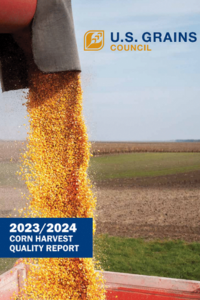According to the U.S. Grains Council’s (USGC’s) 2023/2024 Corn Harvest Quality Report, the 13th such annual survey published globally today, the 2023 U.S. corn crop is the largest on record with the lowest percentage of broken corn and foreign material (BCFM) to date.
 Warm and dry weather conditions in April and May allowed producers to plant ahead of schedule, and despite concerns about continued dryness in June, healthy rainfall returned later in the summer. This allowed the crop to properly mature and resulted in the timely harvest of 386.97 million metric tons (15,234 million bushels) of corn.
Warm and dry weather conditions in April and May allowed producers to plant ahead of schedule, and despite concerns about continued dryness in June, healthy rainfall returned later in the summer. This allowed the crop to properly mature and resulted in the timely harvest of 386.97 million metric tons (15,234 million bushels) of corn.
The average aggregate quality of the representative corn samples tested was better than the grade factor requirements for U.S. No. 1 grade. The report also showed that 88.0 percent of the samples met the grade factor requirements for U.S. No. 1 grade and 96.7 percent met the grade factor requirements for U.S. No. 2.
“The Council is proud to produce this annual report that proves the quality and abundance of U.S. corn year over year. The transparency it provides to buyers helps them make informed decisions and takes another step toward developing markets, enabling trade and improving lives,” said Brent Boydston, USGC Chairman. “This crop’s incredible volume allows the United States to remain the world’s leading corn exporter, accounting for an estimated 26.4 percent of global corn exports.”
The report is based on 611 yellow corn samples taken from defined areas within 12 of the top corn-producing and exporting states. Inbound samples were collected from local grain elevators to measure and analyze quality at the point of origin and provide representative information about the variability of the quality characteristics across the diverse geographic regions.
This year’s corn protein concentration registered at 8.8 percent, an improvement on the five-year average of 8.5 percent. The crop also showed lower average total damage and average moisture content when compared to the five-year average.
The chemical composition of the crop remained in a healthy range, as 99.5 percent of the samples tested below the U.S. Food and Drug Administration (FDA) action level for aflatoxins and 100 percent of the samples tested below the 5.0 parts per million FDA advisory level for deoxynivalenol. Additionally, 98.3 percent tested below the FDA’s strictest guidance level of 5.0 parts per million for fumonisin.
The Council will present its findings to buyers around the world in a series of roll-out events, beginning in China on Dec. 12. Presentations will continue in India, Korea, Panama and Taiwan through the first quarter of 2024 and aim to offer participants clear expectations regarding the quality of corn for this marketing year. During these events, crop quality information is accompanied by updates on U.S. corn grading and handling, that provides importers and end-users with a better understanding of how U.S. corn is moved and controlled through export channels.
Read the full 2023/2024 USGC Corn Harvest Quality Report here and stay up to date on its associated rollout events on the Council’s website. A second Council-produced study, the 2023/2024 Corn Export Cargo Quality Report, will measure corn quality at export terminals at the point of loading and will be available in early 2024.
The Council also recognizes the remarkable efforts made by U.S. farmers to make their operations more sustainable, producing higher yields while using fewer resources. Read more about U.S. corn’s sustainability practices and the Council’s corn sustainability assurance protocol (CSAP) here.
About The U.S. Grains Council
The U.S. Grains Council develops export markets for U.S. barley, corn, sorghum and related products including distiller’s dried grains with solubles (DDGS) and ethanol. With full-time presence in 28 locations, the Council operates programs in more than 50 countries and the European Union. The Council believes exports are vital to global economic development and to U.S. agriculture’s profitability. Detailed information about the Council and its programs is online at www.grains.org.
